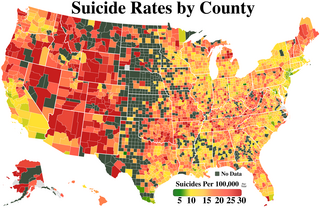Related Research Articles

The Centers for Disease Control and Prevention (CDC) is the national public health agency of the United States. It is a United States federal agency under the Department of Health and Human Services, and is headquartered in Atlanta, Georgia.

Gun control, or firearms regulation, is the set of laws or policies that regulate the manufacture, sale, transfer, possession, modification, or use of firearms by civilians.

A stabbing is penetration or rough contact with a sharp or pointed object at close range. Stab connotes purposeful action, as by an assassin or murderer, but it is also possible to accidentally stab oneself or others. Stabbing differs from slashing or cutting in that the motion of the object used in a stabbing generally moves perpendicular to and directly into the victim's body, rather than being drawn across it.
A cancer registry is a systematic collection of data about cancer and tumor diseases. The data are collected by Cancer Registrars. Cancer Registrars capture a complete summary of patient history, diagnosis, treatment, and status for every cancer patient in the United States, and other countries.

A suicide method is any means by which a person may choose to end their lives. Suicide attempts do not always result in death, and a non-fatal suicide attempt can leave the person with serious physical injuries, long-term health problems, and brain damage.
Public health surveillance is, according to the World Health Organization (WHO), "the continuous, systematic collection, analysis and interpretation of health-related data needed for the planning, implementation, and evaluation of public health practice." Public health surveillance may be used to track emerging health-related issues at an early stage and find active solutions in a timely manner. Surveillance systems are generally called upon to provide information regarding when and where health problems are occurring and who is affected.

A needlestick injury is the penetration of the skin by a hypodermic needle or other sharp object that has been in contact with blood, tissue or other body fluids before the exposure. Even though the acute physiological effects of a needlestick injury are generally negligible, these injuries can lead to transmission of blood-borne diseases, placing those exposed at increased risk of infection from disease-causing pathogens, such as the hepatitis B virus (HBV), hepatitis C virus (HCV), and human immunodeficiency virus (HIV). Among healthcare workers and laboratory personnel worldwide, more than 25 blood-borne virus infections have been reported to have been caused by needlestick injuries. In addition to needlestick injuries, transmission of these viruses can also occur as a result of contamination of the mucous membranes, such as those of the eyes, with blood or body fluids, but needlestick injuries make up more than 80% of all percutaneous exposure incidents in the United States. Various other occupations are also at increased risk of needlestick injury, including law enforcement, laborers, tattoo artists, food preparers, and agricultural workers.

Waterborne diseases are conditions caused by pathogenic micro-organisms that are transmitted in water. These diseases can be spread while bathing, washing, drinking water, or by eating food exposed to contaminated water. They are a pressing issue in rural areas amongst developing countries all over the world. While diarrhea and vomiting are the most commonly reported symptoms of waterborne illness, other symptoms can include skin, ear, respiratory, or eye problems. Lack of clean water supply, sanitation and hygiene (WASH) are major causes for the spread of waterborne diseases in a community. Therefore, reliable access to clean drinking water and sanitation is the main method to prevent waterborne diseases.

Gun violence results in tens of thousands of deaths and injuries annually in the United States. Gun violence became the leading cause of death for children 19 and younger for the first time in 2020 and by 2022, it was responsible for about 100 daily fatalities and hundreds of daily injuries. In 2018, the most recent year for which data are available as of 2021, the Centers for Disease Control and Prevention's (CDC) National Center for Health Statistics reports 38,390 deaths by firearm, of which 24,432 were by suicide. The rate of firearm deaths per 100,000 people rose from 10.3 per 100,000 in 1999 to 12 per 100,000 in 2017, with 109 people dying per day or about 14,542 homicides in total, being 11.9 per 100,000 in 2018. In 2010, there were 19,392 firearm-related suicides, and 11,078 firearm-related homicides in the U.S. In 2010, 358 murders were reported involving a rifle while 6,009 were reported involving a handgun; another 1,939 were reported with an unspecified type of firearm. In 2011, a total of 478,400 fatal and nonfatal violent crimes were committed with a firearm. Gun crimes are covered by 18 USC 922 and 18 USC 924, which are the principal federal firearm statutes.

Gun-related violence is violence committed with the use of a firearm. Gun-related violence may or may not be considered criminal. Criminal violence includes homicide, assault with a deadly weapon, and suicide, or attempted suicide, depending on jurisdiction. Non-criminal violence includes accidental or unintentional injury and death. Also generally included in gun violence statistics are military or para-military activities.

The Surveillance, Epidemiology, and End Results (SEER) program of the National Cancer Institute (NCI) is a source of epidemiologic information on the incidence and survival rates of cancer in the United States.
The U.S. Centers for Disease Control and Prevention's National Center for Injury Prevention and Control's mission is to provide leadership in preventing and controlling injuries, i.e., reducing the incidence, severity, and adverse outcomes of injury, the leading cause of death for those aged 1 – 44. A 1985 National Research Council report entitled Injury in America recommended that United States Congress establish a new program at the CDC to address the problem of injury. Initially the program was supported with funds from the United States Department of Transportation. In 1990 Congress passed the Injury Control Act which authorized the program within the CDC, and in 1992, the CDC formally established the Center. The Center has three branches: the Division of Acute Care, Rehabilitation Research, and Disability Prevention; the Division of Unintentional Injury Prevention; and the Division of Violence Prevention.

Sentinel Event Notification System for Occupational Risks (SENSOR)-Pesticides is a U.S. state-based surveillance program that monitors pesticide-related illness and injury. It is administered by the National Institute for Occupational Safety and Health (NIOSH), twelve state health agencies participate. NIOSH provides technical support to all participating states. It also provides funding to some states, in conjunction with the US Environmental Protection Agency.
The National Outbreak Reporting System (NORS) is an electronic, web-accessible system designed to improve the quality, quantity, and availability of data for waterborne, foodborne person-to-person zoonotic (animal-to-person) enteric disease outbreaks in the United States.
The Waterborne Disease and Outbreak Surveillance System (WBDOSS) is a national surveillance system maintained by the U.S. Centers for Disease Control and Prevention (CDC). The WBDOSS receives data about waterborne disease outbreaks and single cases of waterborne diseases of public health importance in the United States and then disseminates information about these diseases, outbreaks, and their causes. WBDOSS was initiated in 1971 by CDC, the Council of State and Territorial Epidemiologists (CSTE), and the Environmental Protection Agency (EPA). Data are reported by public health departments in individual states, territories, and the Freely Associated States. Although initially designed to collect data about drinking water outbreaks in the United States, WBDOSS now includes outbreaks associated with recreational water, as well as outbreaks associated with water that is not intended for drinking (non-recreational) and water for which the intended use is unknown.

Suicide is a major national public health issue in the United States. The country has one of the highest suicide rates among wealthy nations. Since the beginning of 2023, there have been an average of about 67 suicide deaths per day in the United States. In 2020, there were 45,799 recorded suicides, up from 42,773 in 2014, according to the CDC's National Center for Health Statistics (NCHS). On average, adjusted for age, the annual U.S. suicide rate increased 30% between 2000 and 2020, from 10.4 to 13.5 suicides per 100,000 people. In 2018, 14.2 people per 100,000 died by suicide, the highest rate recorded in more than 30 years. Due to the stigma surrounding suicide, it is suspected that suicide is generally underreported. In April 2016, the CDC released data showing that the suicide rate in the United States had hit a 30-year high, and later in June 2018, released further data showing that the rate has continued to increase and has increased in every U.S. state except Nevada since 1999. From 2000 to 2020, more than 800,000 people died by suicide in the United States, with males representing 78.7% of all suicides that happened between 2000 and 2020. Surging death rates from suicide, drug overdoses and alcoholism, what researchers refer to as "deaths of despair", are largely responsible for a consecutive three year decline of life expectancy in the U.S. This constitutes the first three-year drop in life expectancy in the U.S. since the years 1915–1918.
A suicide attempt is an attempt to die by suicide that results in survival. It may be referred to as a "failed" or "unsuccessful" suicide attempt, though these terms are discouraged by mental health professionals for implying that a suicide resulting in death is a successful and positive outcome.

Sudden arrhythmic death syndrome (SADS) is a sudden unexpected death of adolescents and adults, mainly during sleep. One relatively common type is known as Brugada syndrome.
Abortion, also known as pregnancy termination, was legalized up to the 24th week of pregnancy in New York (NY) in 1970, three years before it was decriminalized for the entire United States with the Supreme Court's decision in Roe v. Wade in 1973. Roe v. Wade was later overturned in 2022 by the Supreme Court in Dobbs v. Jackson Women's Health Organization. The Reproductive Health Act, passed in 2019 in New York, further allows abortions past the 24th week of pregnancy if a woman's life or health is at risk or if the fetus is not viable.
The 2017 Puerto Rico Leptospirosis outbreak was an outbreak of leptospirosis that affected Puerto Rico in the fall of 2017, following Hurricane Maria's landfall.
References
- ↑ Paulozzi, L J (1 January 2004). "CDC's National Violent Death Reporting System: background and methodology". Injury Prevention. 10 (1): 47–52. doi:10.1136/ip.2003.003434. PMC 1756538 . PMID 14760027.
- 1 2 3 4 Steenkamp, M; Frazier, L; Lipskiy, N; DeBerry, M; Thomas, S; Barker, L; Karch, D (1 December 2006). "The National Violent Death Reporting System: an exciting new tool for public health surveillance". Injury Prevention. 12 (suppl_2): ii3–ii5. doi:10.1136/ip.2006.012518. PMC 2563479 . PMID 17170168.
- ↑ Serres, Chris (1 May 2016). "Battling a surge in suicides, Minnesota investigators wield a new weapon: Data". Minneapolis Star-Tribune. Retrieved 21 May 2016.
- 1 2 "National Violent Death Reporting System". Centers for Disease Control. Retrieved 21 May 2016.
- ↑ McKay, Betsy (22 April 2016). "Suicides in the U.S. Climb After Years of Declines". Wall Street Journal. Retrieved 21 May 2016.
- ↑ Hemenway, D; Barber, CW; Gallagher, SS; Azrael, DR (July 2009). "Creating a National Violent Death Reporting System: a successful beginning". American Journal of Preventive Medicine. 37 (1): 68–71. doi:10.1016/j.amepre.2009.03.005. PMID 19524145.
- ↑ Liu, Grace S. (2023). "Surveillance for Violent Deaths — National Violent Death Reporting System, 48 States, the District of Columbia, and Puerto Rico, 2020". MMWR. Surveillance Summaries. Vol. 72. doi:10.15585/mmwr.ss7205a1. ISSN 1546-0738 . Retrieved 2023-05-24.